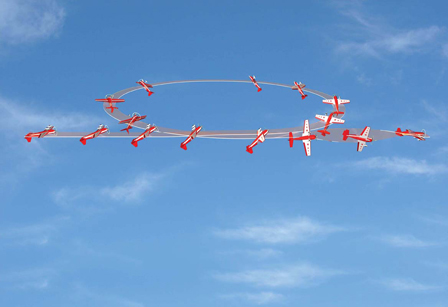An inverted harrier is when the model is inverted at an extreme angle of attack (the fuselage should be at a 45-degree angle or similar) while traveling in the same flight path. The airplane should not lose or gain any altitude while traveling at this angle. Like the inverted harrier, the inverted harrier circle is performed when the model is in an inverted attitude (when the fuselage is at about a 45-degree angle of attack while in inverted flight) while flying a 360-degree circle using rudder input. When you perform the inverted harrier circle, you’ll quickly realize it requires all control inputs.

- Reduce throttle and gradually increase angle to enter the harrier 3D attitude. After the model slows down, add more throttle to maintain altitude.
- Slowly add small amounts of right rudder to enter the horizontal 360-degree circle. Maintain altitude.
- Maintain attitude and altitude with small throttle adjustments. Use a balance of throttle and elevator inputs.
- Maintain 360-degree circle flight path with rudder input. Maintain angle of attack with throttle and elevator, and keep the wings level with aileron.
- Exit the maneuver by continuing the inverted harrier, or you can perform a half roll back to upright then exit straight and level.
FLYING THE INVERTED HARRIER CIRCLE
As with all new maneuvers that you are unfamiliar with, perform them at a high altitude until you become familiar with them. In this example, we will be performing the inverted harrier circle maneuver from left to right. When you are ready to start, establish a heading that is parallel to the runway and fly at a fairly slow airspeed.
Starting in inverted flight in a manner that is parallel to the runway, gradually slow the model down by decreasing the throttle. Now, make sure that you have activated your 3D dual rates and prepare for gradual elevator input to maintain the same altitude. To get the model into the inverted harrier attitude, you’ll need to continuously add down-elevator while making adjustments to the throttle, aileron, and rudder stick to maintain the proper flight attitude.
- Now that the model is in the inverted harrier attitude, you’ll need to use the rudder stick (often in small increments) to start the horizontal 360-degree circle. Please remember to always use small increments of right rudder to steer the model away from both the crowd and the flightline.
- Once the model begins to slow down and the angle of attack increases, you will need to add more throttle. To maintain altitude, use a balancing act of both throttle and elevator. Again, make necessary corrections so that the wings of the model remain level and remember to always use the rudder stick (in small increments) so that the heading of the model remains in a 360-degree circle. A word to the wise: always become familiar with how your model reacts to different control inputs before attempting any maneuver at low a altitude. Some models may be more sensitive to rudder input (these airplanes usually have a shorter wing-to-stabilizer moment), while others will take a greater amount of rudder input (usually airplanes that have a larger wing-to-stabilizer moment).
- Keep in mind that the amount of rudder that will be used (as well as aileron and elevator inputs) will vary depending on the amount of exponential that is used (as well as the overall amount of control surface deflection). Continue the shape of the circle and when the model nears the fourth quadrant, begin to release elevator input while adding throttle to maintain the same altitude.
- You can exit the maneuver by either continuing in an inverted harrier or perform a 1/2 roll to upright level flight.In closing, always remember that practice makes perfect. While the inverted harrier circle is challenging, with the proper practice and amount of dedication it’s possible to master it. However, also remember that pilots must spend time analyzing their aircraft and making the necessary changes to their airplane and radio setup to obtain a favorable result. Lastly, always remember to have fun!























